Copper Run Inside Old Galvanized "Water Service" Line?
Over the years diverse dissimilar materials have been used to install water service lines, also referred to every bit water mains fifty-fifty though that is technically incorrect. What follows is a brief tutorial about the different water main piping material that has used for water supply lines over the years. Most h2o lines for private properties are not actually pipes, simply rather tubing. Learn almost the particular characteristics of each textile. Some h2o service line material such equally pb and galvanized pipe are no longer legal to install or to repair in sure areas, such as in New York Urban center. Likewise notation that plastic as a h2o service line material has never been legal in NYC for use; therefore information technology is not explained in this tutorial.
Atomic number 82 – Atomic number 82 Water Service Lines
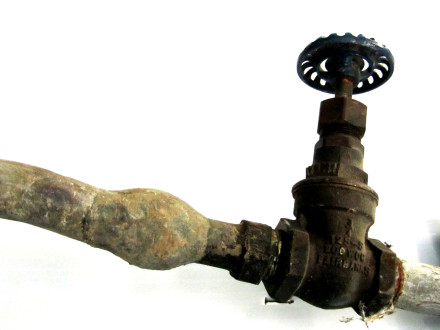
Lead Water Line
Lead is non technically a water primary piping material, equally it is not considered a pipe, and was solely for service lines. Lead has not been an approved material for a water main service in over threescore years. Lead in the drinking supply does not occur naturally; it does not come from rivers, reservoirs, etc. If atomic number 82 is present in a house supply system it typically emanates from the water main distribution system or house plumbing.
At that place are diverse services that exam for atomic number 82 inexpensively. If a house is serviced past a atomic number 82 h2o primary it is strongly suggested that before using h2o the tap be run for 15 to 30 seconds when it has not been run for vi hours or so. This precaution volition help eliminate the possibility of ingesting lead which could lead to lead poisoning.
There are a few means to determine if a water main service line is lead. Atomic number 82 is characterized past a silver color, is malleable, and has a circular shaped "wipe joint" just earlier the main command valve (refer to photo and video). Wiped joints had to be used because lead cannot be threaded like a piping tin can.
The NYC DEP code does not allow the repair of an existing lead h2o service line. If repair work is needed on a lead service line, by law it must be fully replaced. In improver, once an existing lead water service is moved in any manner tiny hairline cracks are made. These small cracks, which may non even be visible, will form into a leak typically inside 18 months or less.
Galvanized – Galvanized Water Main Pipe Material
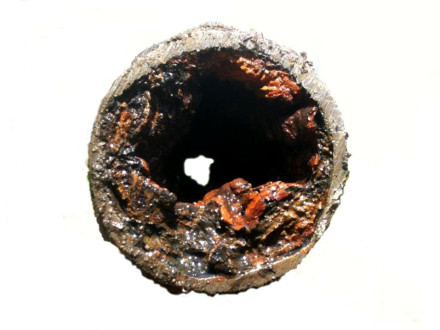
Galvanized pipe
Galvanized pipe, when used for water main service lines, are primarily found in only certain areas of NYC. Mostly residents with galvanized lines were previously serviced past a private water supply company such as Jamaica H2o (JWP).
Galvanized is a water master piping material that is actually a pipage. A pipage has the characteristic of beingness able to exist threaded on each cease, and is rigid. Galvanized pipe is not legal in NYC as a fabric for a water service.
Galvanized pipe reacts to contact with water or moisture, and corrodes on both the outside and within of the piping (refer to photo and video). Information technology is similar to a clogged avenue in a person – only instead of a centre attack you get a flood! It is strongly suggested that any existing galvanized water service be replaced immediately with amend materials, every bit when they leak the service typically ruptures.
The NYC plumbing lawmaking does not permit repairs on existing galvanized h2o main service lines. In addition repairing an existing galvanized water service would be a repair with little integrity. The aforementioned applies for an existing lead water service line.
Information technology is easy to determine if a h2o service is galvanized as information technology is the but h2o service material that is magnetic. Simply place any magnet on the water service, if it sticks the service is galvanized.
Typically when h2o is turned on in a business firm with galvanized piping the initial water will be rust colored or contain rust. Impurities in levels such every bit these are not typically plant in copper water services
Copper – Grand Copper H2o Service Line Tubing
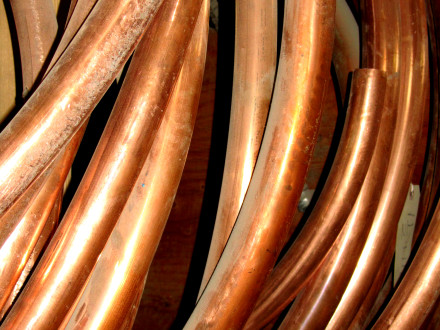
Domestic 1000 Copper H2o Tubing
M type copper is the material that the vast majority of water services lines are presently installed with in NYC. Grand copper is really water tubing, not technically a water master pipage cloth. In improver most existing water services are G copper. K copper tubing (not pipage) is used for water services up to 2″ in size.
K copper water services are characterized past flare fittings at the terminate of the tubing (refer to photos below) and the fact that they are malleable and able to curve without damaging the service line.
The fact the copper h2o tubing is malleable is a cardinal factor in why they last so long. This enables copper tubing to withstand basis shifting ameliorate than other approved plumbing materials. Thou copper water services typically have a lifespan in backlog of 50 years. [Read more about copper h2o service lines]
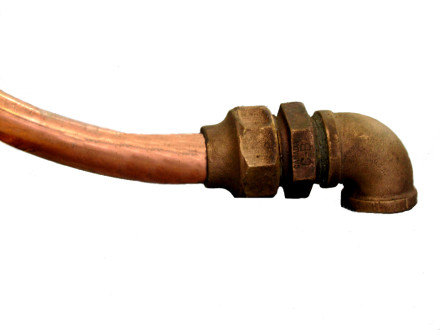
Chiliad copper connected using flare fitting
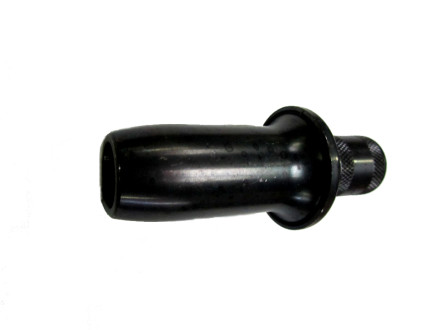
Thousand copper flaring tool
Brass – Brass Water Main Service Lines
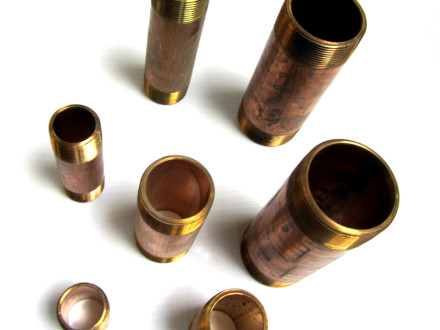
Contumely pipe
Brass pipe is threaded at each and is continued by the use of brass couplings. Brass is classified as a water chief pipage material, every bit it is actually pipage. Brass is generally used solely for a ii one/2″ water service line in New York City. Therefore it is a material that is used infrequently. Some other factor limiting the use of Contumely is that it is extremely expensive compared to other approved water supply line materials.
Brass is a metal composed primarily of copper and zinc. Copper is the chief component and brass is usually classified every bit a copper alloy material. Brass is stronger and harder than copper, simply not every bit strong or every bit hard as steel. Brass water service lines have a life expectancy in excess of 50 years. Unlike copper water tubing, brass is not malleable. But contumely pipe does have a thicker wall thickness than K copper water tubing.
Brass is not a magnetic fabric; so to exam whether a h2o service is galvanized or contumely a magnet tin be used. Galvanized is a magnetic material. Brass and galvanized piping can appear similar to the naked eye, but take very dissimilar characteristics and properties. Both contumely and galvanized are threaded pipe, however unlike galvanized pipe brass is a legal material in NYC and has a much longer life expectancy.
Ductile Atomic number 26 Piping – Ductile Iron Water Main Lines
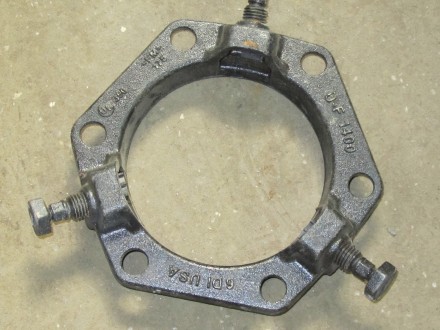
Retainer gland for ductile iron pipe
Ductile Iron piping is a cement lined material used for water services larger than 2″ in diameter. Typically used for fire sprinkler mains, or for buildings such as large apartment or part buildings.
Ductile Fe pipe is the same h2o main pipe material that NYC uses for its distribution system. Once installed, ductile iron pipe lasts for many decades. Our of all the materials used, Ductile fe may be the most durable h2o master pipe material, or tubing material, approved for use in NYC.
Ductile iron piping is unique in that it is put together using either button-on joints, or mechanical articulation retainer glands with fix screws. That means it is typically non threaded like typical pipage, nor flared similar copper tubing. Ductile Atomic number 26 Mechanical Articulation pipe contains no atomic number 82 whatsoever (refer to photos).
In some specific instances, such equally unstable ground weather, ductile fe pipe is used for firm sewer installations likewise as for a h2o primary, or water service line. Previous to the advent of Ductile Atomic number 26 piping, cast fe was utilized for these same installations. Cement lines Ductile Iron pipe is far superior and longer lasting material than cast iron, or extra heavy cast iron.
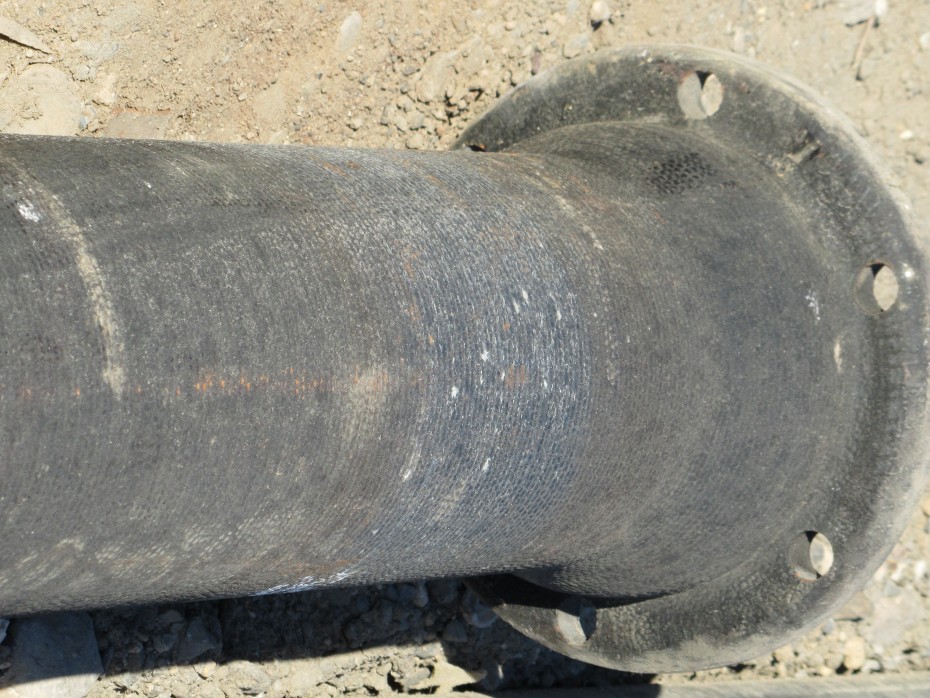
Ductile iron pipe
Go proficient communication today
Source: https://www.balkanplumbing.com/nyc-water-main-pipe-material-tutorial/
Posted by: chenaultanneized.blogspot.com


0 Response to "Copper Run Inside Old Galvanized "Water Service" Line?"
Post a Comment